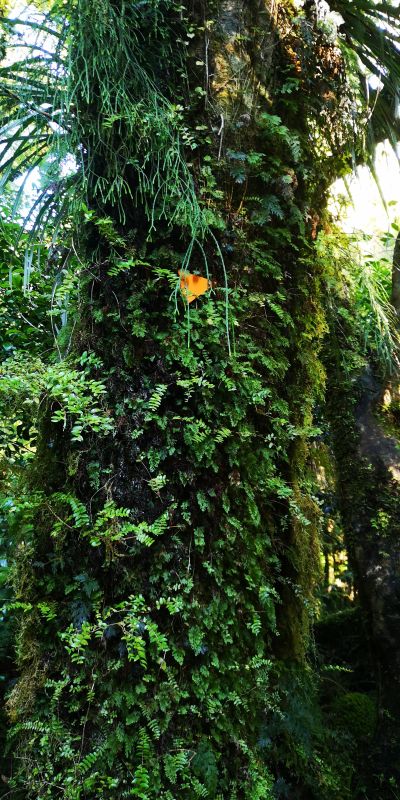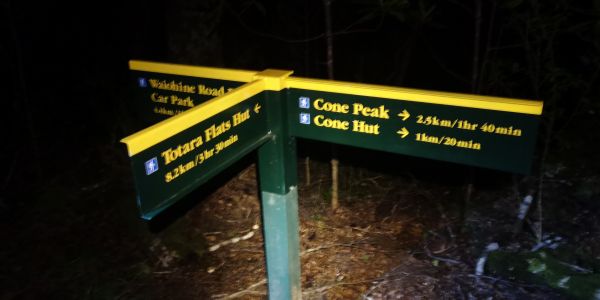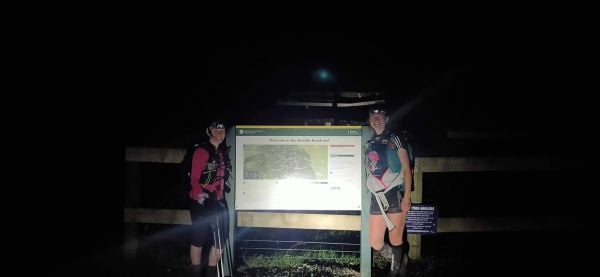The S-K Valleys

Katie Wright
October 14, 2020 13 min readI write this with the assumption that anyone reading will be familiar with the long history of the ‘SK route’. Even before moving to North Island I was waiting for the opportunity to come and explore the Tararuas and see for myself how my body and mind would hold up. My first introduction to the area was ‘interesting’ involving crossing the steel ladder in the dark (semi-unintentional) and a post-midnight finish. Certainly proof of everything I had read. I was hooked.
Skip ahead a few months and I had managed a few short weekend trips with every intention to explore the Valley route, but mainly being tempted by good weather to the tops. The plan had been to do the majority of the route in sections before giving the ‘real thing’ a crack. With cancelled races (Covid), time off work and an easily persuaded friend to join we decided it was time to just jump in and go do the damn thing! The only problematic factor was the ever-rising river levels on the Ruamahanga: A section that, if the river is high, requires a large amount of sidling up banks. Less than ideal. Cue a week of nervous weather watching and hitting refresh on river levels. After gathering knowledge from a variety of sources (thanks hugely to the BSR community for their breadth of knowledge and willingness to share!) we decided anything over 400 mm and we would consider our alternative options varying from an energy sapping detour up and over Cattle Ridge to a ‘KK’ from Kiriwhakapapa to Kaitoke - missing the entire river section out.
 With back-up plans in place we found ourselves at Putara basecamp at 4.45 am during the tail-end of winter, scraping ice off the car windscreen. “We are NOT going for a swim today”, Elly tells me. Having been reliably informed that ‘this time of year there is usually a compulsory swim or two’, I shrugged my shoulders and we drove off. No phone signal to give the river levels a final check we were at least comforted by the lack of rain and a reading of 420 mm the night before.
With back-up plans in place we found ourselves at Putara basecamp at 4.45 am during the tail-end of winter, scraping ice off the car windscreen. “We are NOT going for a swim today”, Elly tells me. Having been reliably informed that ‘this time of year there is usually a compulsory swim or two’, I shrugged my shoulders and we drove off. No phone signal to give the river levels a final check we were at least comforted by the lack of rain and a reading of 420 mm the night before.
The InReach pinged a message just as we were coming across the first swing bridge. River stage 399 mm. It’s a go (lucky really because I doubt there was any turning back by then and Cattle Ridge looked pretty unforgiving!). The headtorches came off not long after starting the descent to Roaring Stag: the first hut on the route and the start of the only unmarked section of the day. The hut was empty and we took a few minutes to re-fill bottles and fill in the hut book. Crossing the bridge and turning onto the true right of the river we managed to hop along the boulders at a reasonable pace. After half an hour or so I heard a thud behind me that didn’t sound great. Elly’s knee had lost a fight with a boulder and was already starting to swell. Paracetamol time and a short walk to ease the pain off and we were back at it. Keeping to the true right there were a few occasions we had to sidle up the banks to keep from getting higher than knee deep into the river, but not too many. Looking back, I think even if the river had been a fair bit higher, we would’ve been ok.

Closing in on Cleft Creek the options were to either cross and commit to a swim or attempt a scramble up the bank and hope we found a suitable crossing point further up. Avoiding the swim seemed like the best plan of action and up the bank we went. Without too much time lost to navigation and climbing we had crossed safely over the other side, no swim required, and back onto friendly orange triangle territory. Getting up to Cow Saddle I was back on trails I had covered before and we cruised down to the familiar Cow Creek: from 5 or so trips into the Tararua’s I have somehow managed to visit Cow Creek 5 times and stay over a few nights too. Feels like home! A few quick photos and onwards to Mitre Flats.
Getting up to Cow Saddle I was back on trails I had covered before and we cruised down to the familiar Cow Creek: from 5 or so trips into the Tararua’s I have somehow managed to visit Cow Creek 5 times and stay over a few nights too. Feels like home! A few quick photos and onwards to Mitre Flats.
I had read about the infamous slippery bridge. I had tramped this section before. We came across the bridge nicely covered in wire. Getting past that with zeros issues we carried on pushing through the long grass, minimal visibility of where feet were being placed. Then suddenly I was on my arse. ‘Who put this F**king plank here!?’ At least now I feel truly initiated into the Tararua fastpacking scene. The phone in my back pocket took most of the force, fortunately it was the glass at the back rather than the screen that decided to shatter into pieces.
We had a longer stop at Mitre Flats to restock front pockets with more food, remove debris from shoes and take stock of where we were headed. The route from here was all unknown territory for me but I was reliably informed the next section was a highway in comparison to the rest of the day! Coming up to Atiwhakatu we came across the first trampers of the trip and with the most runnable sections of the day we gained some speed. Classically the only big group (a family of 5) we came across was queued up waiting to cross a 1-person swing bridge. Elly piped up asking if we could push in and hopped on leaving me to explain to the slightly bewildered family what we were doing! Turning off the nice flat wide track up towards Pig Flat we climbed again arriving at the top of the climb just after 15:15. With reliable mobile signal for the first time we sent a few messages out to confirm how things were going, caught our breath, and carried on towards Totara Flats.
Just before peeling off towards Totara Flats we came across the final group of trampers for the day who asked where we had come from: ‘Oh…. Um… Putara’. We were met with that slight puzzled look of people trying to work out where that is on the map, turning to shock/disbelief when they work it out.
The descent to Totara Flats swinging through the trees and slipping through mud was pretty fun from my part. Elly’s knee unfortunately did not agree and the pain killers made another appearance before we pushed on through the Flats.
We’d hoped to get most of the climb to Cone Saddle done in the light. Around three quarters of the way up we admitted defeat and got the head torches out. It’s funny how taking your mind off the track even for a second can disorient you. The 30 seconds of getting torches out of a pocket and the difference in how everything looks via a headlight. We were off track within a few paces! Fortunately, with GPS and getting accustomed to the torchlight, it was hardly any time before we were back on track. Thanks to some new markings, decent ground trail and a formula of ‘it’s always just up’ navigation to the Saddle from then on was pretty spot on. The bonus of travel by night is that I always feel for some reason the top manages to come sooner. No deceptive false tops to trick you!?
We reached the signposts for Cone Hut. Now, we all know that DOC signs can be a little unreliable. Generally, that’s an overestimate in terms of time required. Unfortunately, whoever decided the time estimates around these parts made them more appropriate for the Kilian Jornet’s of the world which, especially 14 hours into a run, is a little disheartening!
The hut did come eventually- after closer to a mile and 30 minutes! From previous timings it was evidently possible to do this section in 3 hours: sub 18 territory. Motto for the next three hours ‘don’t get lost!!’ After a false start running back to the hut to pick up poles and gloves, we headed out just before 8 pm. Getting onto the Tutuwai Flats we weaved in and out of the trees onto the river, losing the track on multiple occasions, trying to work out in the dark the if sticking to the boggy flats was quicker than trying to keep to the path. Neither of us having done this section before it was a bit of a guessing game.
Reaching the turn off for Tutuwai Hut we decided against the quick stop. Only for me to start following a ground track up a side stream, scrambling over fallen trees up a steep bank for 5 minutes before Elly yelled over the roar of the stream ‘Is this right!?’. Staring at an old orange triangle and ground trail in front of me (despite the windfall covering) I yelled back ‘yes’. Barely able to hear each other we eventually regrouped, checked the GPS and after some convincing I finally admitted yes, this was quite clearly not where we were supposed to be! Four minutes back down the hill, but at least back on track. From here at least navigation went well!
Over the river through Smith Creek: less than a Backyard loop from here: how bad could that be!? Elly’s quite accurate retort being ‘yes but does a Backyard normally have a Puffer to get through? It’s called that for a reason you know!’ In reality the final climb didn’t feel too bad. Navigating the final slip-slide of wet clay down from Puffer Saddle was probably more difficult, although neither were done at close to 6.7 kmph pace! The glow of a lone torch in the carpark below just never seemed to get any closer! After an eternity we stumbled upon a fence in the dark: the carpark appeared out of nowhere and we were done! 18 hours 28 minutes or thereabouts. Veggie pizza, chocolate milk and a friendly face to welcome us in. Huge thanks to Kyle for coming to meet so crazy strangers in the middle of the night!

Back at basecamp well past midnight and up a rickety ladder to bed by 2.30 am. I don’t think I ever sleep well after a big adventure but this time around it wasn’t just the twitching legs keeping me awake. More the mind already planning future attempts and adventures in this epic playground.

Gear:
I absolutely love checking out other people’s gear selection and am still working on mine for fastpacking/long adventures in the hills: here’s what I took suggestions welcome!
Clothing:
Shoes: Salomon Speedcross 4 shoes reasonable grip and good fit for me
Socks: I’m so far blessed with feet that don’t usually blister the Innov8 all terrain mid socks are my go to, cheaper than a lot of others and comfy
Trimtex orienteering shin guards: I usually wear calf sleeves but trialing these after getting ripped to shreds at revenant. Still got a few good bruised but overall solid: needed some glide to stop rubbing just below the knee.
T8 shorts and underwear: I love these I have tried three different brands of race belt and always find them too constricting but hate wearing a vest for shorter runs. On longer runs they just add that bit of extra accessible space for snacks/rubbish/ gloves/phone etc.
Shockabsorber Ultimate run bra: Does the job and no chaffing issues
Standard race T-shirt: because you get so many why would you buy one!?
Buff: Ditto
Kalenji cycling windproof: this is quite possibly my favourite bit of kit easy to take on and off on the move great extra layer not too sweaty in the heat cost about $20, weighs next to nothing. I have used it for every single adventure in the hills since running around Wales in 2017. That’s a lot of miles. It got it’s first tears curtesy of the final swing bridge of the SK and I nearly cried.
Mooncup: because 5 days a month is a lot of time to sit around doing nothing but bleed.
Btwin gloves: cheap and cheerful but do the job to protect hands and stay relatively warm (I don’t tend to suffer from cold hands).
Kit in the bag:
Osprey dyna backpack 15L: fits like a glove, well placed pockets big enough to fit all nutrition, mini first aid kit and phone within reach without taking the pack off. Great hip strap (for me this is essential if carrying 6+ kg of weight). Downside is lack of easy access to pole storage: Working on adapting this. Also on the heavier side. I’ve tried 4 packs of a similar size now and this is the only one that’s come close to working well for me!
Kathmandu down jacket: Even in the summer I’m reluctant to go on a big day out without a properly warm layer
Long sleeve layer: for the ‘just incase’
Kathmandu Zeolite active jacket ‘waterproof’: this is not waterproof and I really can’t recommend it except as a not too expensive but not too heavy ‘seamsealed’ race jacket. Taken more as an extra layer with no forecast heavy rain. If it was due to actually rain or we were on the tops I’d of taken a proper jacket.
Spare socks: probably unnecessary in retrospect!?
Hat: ‘just in case’ courtesy of the Revenant
Leggings: just in case and to change into after
First aid kit: Small strips of Blister tape KT x 5, 1 mid-size wound dressing, Steri-strips, gauze, self-adhesive strapping tape, scissors, paracetamol, ginger tablets, single dose of ibuprofen (Last resort I don’t use NSAIDs regularly during races or similar efforts), small pot of Bodyglide for reapplication if needed. Cannula for popping blisters.
Safety bag
Heavy duty hand cream: tiny tube good as extra lube if needed.
PLB: I have a Kti one although currently registered to call my parents in the UK who didn’t exactly know where I would be so took Elly’s instead: Do you always sent your travel plans to whoever is registered as your PLB contact!?
Powerbank: with 5 + charges and cables for phones/headtorch
Fenix Hl18r headtorch: I tried several alternatives before just rebuying the new version after putting the old one through the wash. Not the brightest (If doing navigation off track I’d prefer something with more lumens) but lightweight ?52 g rechargeable with USB and lasts a whole night in reality rather than just on the box.
3 x 500 ml Wild Things soft flasks: two with Tailwind concentrate one for plain water (only one concentrate made up at a time but for ease of refilling took a ready to makeup concentrate).
Stuff Elly had:
Firelighters and lighter
Spare headtorch (one between us)
Garmin InReach
Compass and paper map
Nutrition:
I try count up my calorie intake following a long training run to get an idea of what works and what doesn’t. Generally I’ll only take in around 200 kcal/hour. I wanted to try and see what happened if I really upped this and concentrated more on carbohydrate specific intake rather than calorific. I also counted and included some specific protein for the first time (tailwind rebuild).
Long story short I felt pretty great the whole day obviously loads of other factors at play but it’s the first time I’ve ever hit 60 g of carbohydrate/hour. The only downside is that the 6000 kcal I ate weighed 1.7 kg and had to be carried. I’d also erred on the side of caution and put in enough food for 24 hours plus an emergency meal meaning another 850 g.
Food for the day:
Tailwind Endurance x 22 scoops of 100 kcal
Tailwind Rebuild x 2 sachets
Spring energy: Wolf pack x 2, Speednut x 2, Power Rush x 4
Bumper bar x 2
Chocolate muffin bake x 2
Cheese muffin x 2.5
Salt and vinegar chips x 50 g
Mars bar x 1


